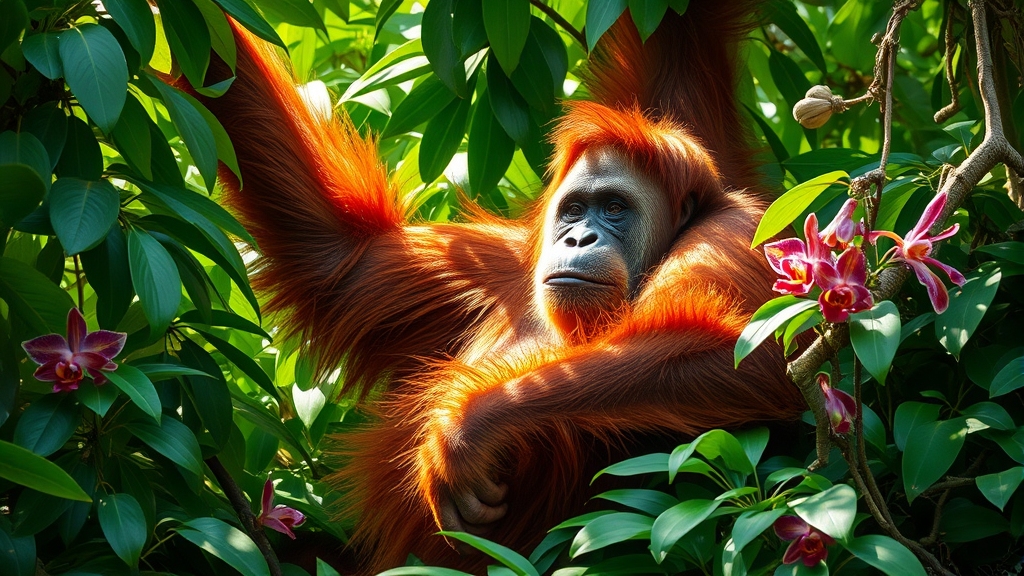Orangutans of Borneo are essential forest guardians, but they face imminent threat from habitat loss caused by logging, palm oil plantations, and deforestation. As you become more aware, you’ll see how conservation efforts like wildlife corridors, community involvement, and technological strategies can help protect these gentle, intelligent primates. Preserving their habitat is crucial for their survival and the health of entire ecosystems. Keep exploring to discover how you can support their future.
Key Takeaways
- Orangutans are highly intelligent, gentle primates native to Borneo’s rainforests, now critically threatened by habitat loss.
- Deforestation from logging and palm oil plantations fragments their habitat, risking inbreeding and extinction.
- Conservation efforts focus on establishing wildlife corridors and protected areas to ensure safe movement and habitat connectivity.
- Community involvement, reforestation, and sustainable practices are vital for preserving orangutan populations.
- Public awareness and policy support are essential to balance human development with orangutan habitat conservation.

Have you ever wondered what makes Borneo’s orangutans so unique? It’s their incredible intelligence, gentle nature, and remarkable ability to adapt to the dense rainforest that sets them apart. But beneath their captivating qualities lies a fragile existence, threatened by human activities like logging, palm oil plantations, and deforestation. Protecting these gentle creatures requires more than just awareness; it demands active efforts in forest conservation and the creation of wildlife corridors. These corridors are essential pathways that connect fragmented forests, allowing orangutans to move safely between habitats. Without them, isolated populations become vulnerable to inbreeding and local extinction. You can imagine how crucial these corridors are—acting as lifelines in an increasingly fragmented landscape. They help maintain genetic diversity, which is vital for the species’ resilience and long-term survival. Forest conservation initiatives aim to preserve large, contiguous tracts of orangutan habitat, not only to safeguard the animals but also to support the entire ecosystem that depends on these forests. When forests are conserved effectively, they provide a sustainable environment for orangutans to forage, breed, and thrive. You might not realize it, but your support or awareness can contribute to these efforts—whether it’s through donations, spreading awareness, or choosing products that don’t contribute to habitat destruction. Protecting orangutans isn’t just about saving a single species; it’s about preserving the intricate web of life that sustains Borneo’s rainforest. The creation and maintenance of wildlife corridors are a practical step toward this goal, ensuring these intelligent primates can access different parts of their habitat without risking injury or death from crossing dangerous human-made barriers. It’s a proactive approach that balances development with conservation, acknowledging that humans and wildlife can coexist if we take the right steps. Forest conservation efforts often involve local communities, government agencies, and conservation organizations working together to safeguard these essential habitats. Initiatives include reforestation, patrols against illegal logging, and the establishment of protected areas. Recognizing the importance of seed-based diets in traditional practices highlights how sustainable and resourceful approaches to habitat management can support biodiversity. Supporting community-led reforestation projects has proven to be an effective method for restoring vital orangutan habitats and fostering local stewardship. Additionally, employing innovative conservation technologies can significantly improve monitoring and protection efforts for these primates. Incorporating remote sensing tools allows conservationists to detect habitat changes more efficiently and respond promptly to threats. Furthermore, creating connectivity corridors enhances the capacity of orangutans to thrive in their natural environment, reducing human-wildlife conflicts. As someone who cares about the future of orangutans, understanding the importance of wildlife corridors and robust forest conservation can inspire you to support or advocate for policies that prioritize habitat preservation. The survival of Borneo’s orangutans hinges on these combined efforts, and your awareness can be a catalyst for change. Ultimately, their fate depends on our actions today—whether we choose to protect their forests or allow their habitats to vanish, leaving these gentle guardians of the jungle on the brink of extinction.
Frequently Asked Questions
How Do Orangutans Communicate With Each Other?
You might wonder how orangutans communicate with each other. They use a variety of vocalizations patterns, like long calls and grunts, to convey different messages, such as warning or attracting a mate. Additionally, they rely on gestural communication, like arm movements and facial expressions, to share their feelings or intentions. Your understanding of their communication shows how complex and fascinating these intelligent primates are, highlighting their need for conservation.
What Is the Average Lifespan of Bornean Orangutans?
Imagine a life that spans decades, like a gentle river flowing through time. Bornean orangutans typically live around 30 to 40 years in the wild, their genetic variation essential for survival. Conservation efforts help protect these gentle giants, ensuring their long, precious lives. Without such efforts, their future remains uncertain, and each passing year dims the hope for their continued existence on this fragile island.
Are Orangutans Affected by Climate Change?
You might wonder if orangutans are affected by climate change. The impacts of climate change, including increased temperatures and unpredictable weather, worsen habitat loss for these primates. As forests shrink and food sources become scarce due to climate change impacts, orangutans struggle to survive. Deforestation and changing climate patterns threaten their habitat, making it harder for them to find food and reproduce, pushing them closer to extinction.
How Do Orangutans Influence Their Ecosystem?
You might wonder how orangutans influence their ecosystem. They play a crucial role through their diet diversity, consuming a variety of fruits, leaves, and insects, which helps disperse seeds and maintain forest health. Their nesting behavior also affects tree growth, as they often select specific trees for resting. By doing so, orangutans help sustain the forest’s balance, making them essential guardians of their environment.
What Are the Main Threats to Orangutan Genetic Diversity?
You should know that habitat fragmentation and poaching threats mainly reduce orangutan genetic diversity. When their habitats break into smaller patches, it limits their movement and breeding options, leading to inbreeding and loss of genetic variation. Poaching further diminishes their populations, making it harder to maintain healthy gene pools. These combined threats threaten the long-term survival and adaptability of orangutans, pushing them closer to extinction.
Conclusion
You can truly make a difference by supporting conservation efforts for Borneo’s orangutans. Some believe that restoring forests and reducing palm oil demand will save these gentle creatures. While challenges remain, your awareness and actions can help protect their habitat. By choosing sustainable products and spreading the word, you contribute to their survival. Remember, every small step counts in keeping these forest guardians thriving for generations to come.








